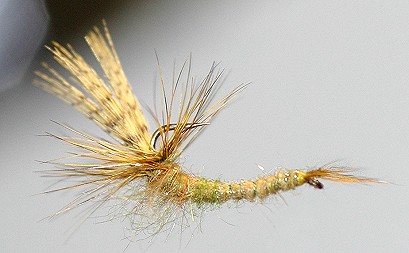Avon Special
By Roy Christie, Harrow, UK
This was it. I was made up. I had just managed
to arrange my first day on the crystal waters
of the Upper Avon in Wiltshire. Having spent
some years fishing lakes I was graduating to
the hallowed waters popularised by Sawyer and
Kite. I had my dry flies to hand, they had been
ready for ages. There were patterns to cover
everything known to float on, walk on and drop
onto water. This was of course dry fly water
until the sixteenth of June, dry and upstream
nymph thereafter.
So it was, in 1983, that I parked up near Old
Sarum a few miles upstream from Salisbury and
took my Sharpe's 88 #5/6 past the hut and signed
in. I took a token for the beat where the sluice
empties the river into a great hatch pool with
swirling back eddies, monster deeps, massive
weed growth and a great river passing under
the leafy canopy. There was a gentle upsteam
wind and light cloud in a pale blue sky. It
looked perfect on the map on the keepers board.
Johno the water keeper was a friendly and
informative chap, dressed in a large hat, shirt,
boots, waistcoat, flannels and chaps. One could
tell he was a man who knew the countryside and
particularly his stretches of water. He reckoned
the pool contained some very good fish and they
should be moving to surface fly throughout the day.
I was recommended to try Black Midge #18; Adams
#16, Wickhams Fancy; and to keep an eye open for
any small caddis. I thanked this kind,
wildly-bewhiskered gentleman for his advice and
made my way along the river.
Keeping low on the journey upstream for about
half a mile, in order not to disturb any of
the beats for later, I noted lots of insect
life, all manner of small bugs in the grass.
Sedges were flitting and fluttering and lots
of small mayfly duns were floating downstream
against the light warm wind. Occasionally there
would be a tell-tale ring where some unseen
predator had just taken a morsel from the
surface.
Arriving at the pool, which was a touch cooler
than the preceeding half mile, I surveyed it's
complex flows. It was everything I could hope
for - fast water; back eddies, long glides,
broken water and broken light as the sun
filtered through the trees. And the fish were
on the fin, feeding on something unidentifiable
in the surface film. Idyllic.
I was ready to disturb this idyll by stealth and
cunning. Prior to my lake fishing in Southern
England, I had grown up by a trout strean, where
I had had outstanding success with the dry fly
and upstream nymph on the moorlands. Now I was
about to address the fish of the Avon.
Putting a tiny Tups Indispensible on a 3lb tippet,
I set it to drift over an area where an impressive
ring had disturbed the glide not long back. As the
size 16 prize floated down there was a sip under
the fly; but the Tups carried on downriver - rejected -
not good enough. Changing to a #18 Adams, I checked
that the landing net was free and ready. I put the
Adams on a Shepherd's Crook cast, so the fly
preceeded the leader and she drifted down towards
the feeding monster. Again a tiny sip; again the
fly floated on down. A second cast had the same
response. The third received no attention! I
seemed to be having a problem with this fish.
Replacing the fly with a size 18 Black Gnat
should sort him out. I reeled in and rested
him for a few minutes while I changed the fly.
The cuckoo was singing, the butterflies were
doing what they best do under the canopy of
the trees. It was still a beautiful day.
I put the Black Gnat on the tippet; floating
line and leader with degreased point and
checked for knots. All was perfect. My pal
the brownie, now rising regularly, had
restarted feeding.
I mentally prepared the cast. It was a long
way, maybe eighteen yards across the slack
water to get the fly on the faster glide with
a little compensation for the back eddy. I
dropped a couple of yards extra and the gnat
fell fine. I removed a yard of slack line and
the fly glided just right, right over the head
of a fifteen inch brown trout who came up,
inspected the delicate offering and turned
down to his lair in distain. Obviously I had
encountered an educated fish. I had heard
about these. I moved upstream a few yards
to survey the rest of the pool.
Everything I could have wished for was in
that pool. It was a perfect holding area
for brown trout, grayling, chub in the back
eddies; even occasionally an Avon salmon,
huge and formidable.
Some trout were moving up ahead so I thought
to cut to the chase. There were four or five
of them feeding hard in the main stream. I
presented my gnat. There was a boil under
the fly but no connection. This process
was repeated until the fish stopped feeding.
Now I could see why fishing the nymph was
so popular. What I needed was a nymph, just
in - not on the surface, as that was what
the trout were locked on to.
Nothing else would suffice.
I decided on my return home, fishless, of
course, to design a fly which - whilst
within the dry fly rule - would represent
the mayfly at the point of emergence from
its shuck at the surface of the water.
The next week, 'dry flies' at the ready -
the Avon Special Emergers in their prized
position, representing the hatching mayfly -
I set off toward Old Sarum once again.
The hatch pool was occupied. I took the one
below, also a lovely beat. Fish were rising,
refusing the dry flies again. I put on the
new emerger in a medium olive #16 and drifted
it down the glide. In twenty minutes I caught
two lovely brown trout and three beautiful
grayling. The fish were returned to show
disdain another day.
The Avon Special will fish upside down in
the surface film with the wing sticking
upward from the bend of the hook, for
purposes of aerodynamics and visibility.
Materials: Avon Special
Hook: Longshank up-eyed grub/scud hook.
Thread: Uni yellow 8/0.
Hackle: High quality indian cree, dyed
gold, as a general pattern. Any good hackle of
your choice will do. Tie to match the hatch.
Rib: Fine copper wire or mono tippet.
Tails: Hare's mask fibres, or hackle fibres.
Abdomen: Medium olive dubbing mix, to
match the hatch.
Thorax: Orange/olive dubbing mix, to
match the hatch.
Tying Instructions: Avon Special
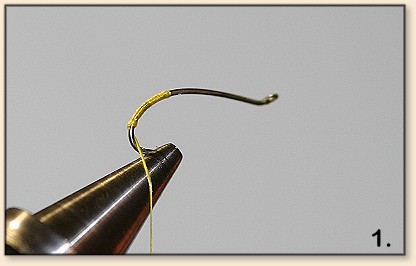
1. Place hook securely in vise, as shown,
and run the thread to halfway round the bend.
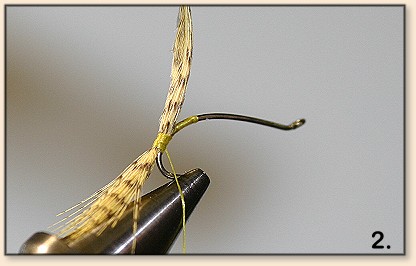
2. Tie in a woodduck or mallard body feather
as a wing as shown. Wing height should be
about one and a half times the hook gape.
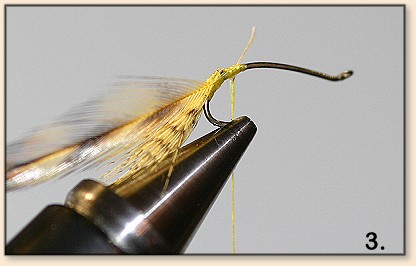
3. Tie in a rooster hackle to match the hatch.
The hackle barbs should be about one and a
quarter times hook gape. A good quality Indian
hackle performs well. Cree is great, dyed gold.
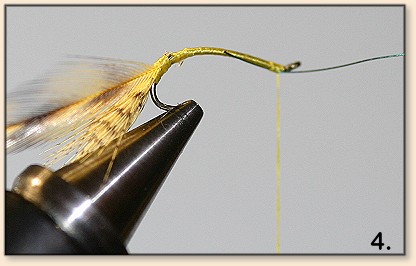
4. Run the thread back to the hook eye, tying
in the ribbing wire.
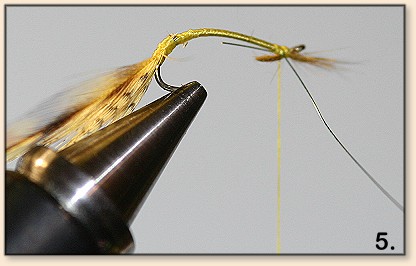
5. Tie in the hare's ear fibres for nymph tails.
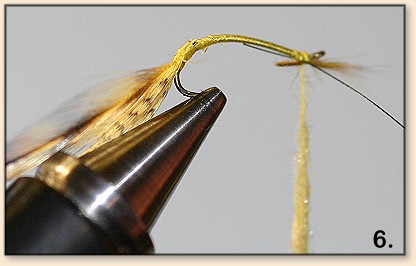
6. Apply dubbing mixture for the abdomen to the thread.
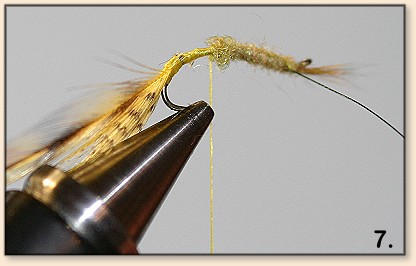
7. Wind dubbing mixture onto the abdomen and
secure with a two turn whip.
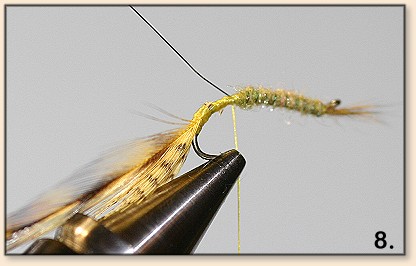
8. Rib body with wire, secure; cut off excess.
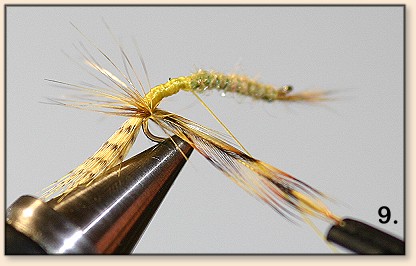
9. Wind hackle into hook bend, as shown.
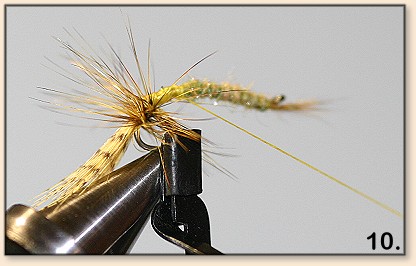
10. Wind thread up thorax area and one third
way through the hackle.
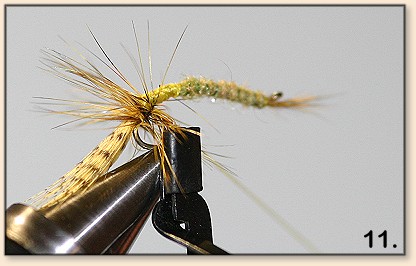
11. Now nip out the hackle tip and pull the hackle
up over the wing. Wind the thread back over
the hackle roots (funneldun style).
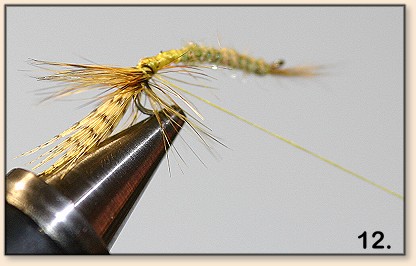
12. Dub thorax mixture onto thread.
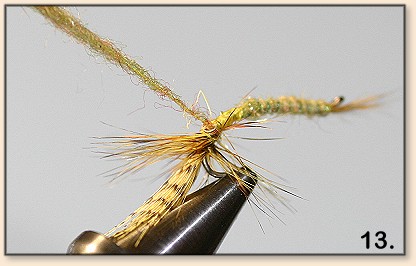
13. Wind the dubbing as a thorax, secure
with a four turn whip finish.
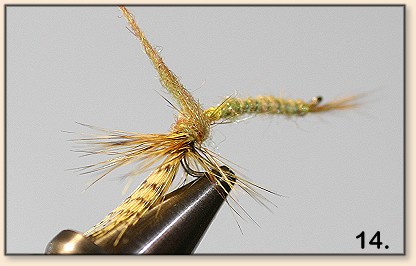
14. Apply another tiny pinch of dubbing
to the thread.
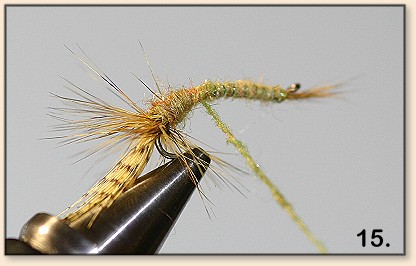
15. Use it to whip finish over the previous
knot and hide it.
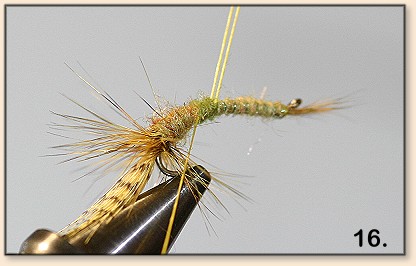
16. Pull the whip finish into place.
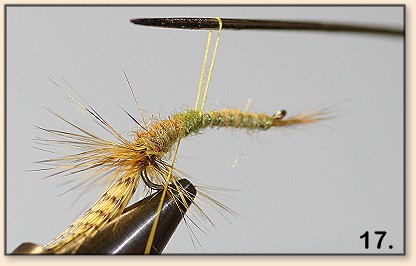
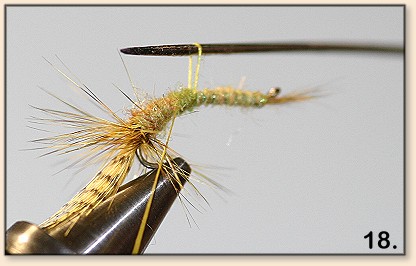
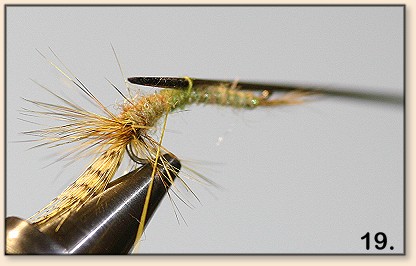
19. Completed fly.
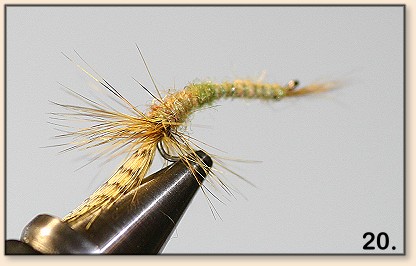
20. Pick out some fibres from the thorax area
for nymph legs.
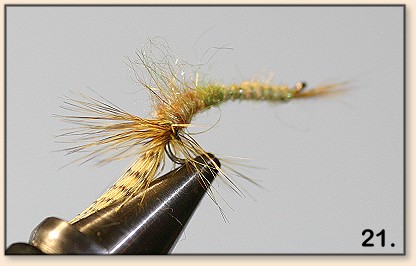
21. Completed fly, again.

Fishing Tips:
This fly is special for me because it proved
to be the perfect resolution to a problem
encountered with fussy and selective trout.
It is especially great as it was my first
introduction to the beautiful grayling. Also
the fly can be modified to imitate midges and
is particularly useful in flat calm conditions.
It even evolved into a reversed parachute fly
but then that is another story. ~ Roy Christie
About Roy:
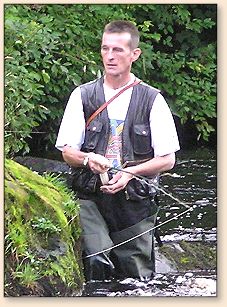 Born 1953 near the Giant's Causeway, Northern
Ireland; started fishing when I was four or five,
flyfishing a few years later, tying flies since
I was about ten years old, bred bantams ducks
and pheasants for their feathers. Self taught
tyer, learned from Hanna, Skues, Stewart and
Pritt. There were fairies at the bottom of the
garden and a trout stream at the end of the
first field.
Born 1953 near the Giant's Causeway, Northern
Ireland; started fishing when I was four or five,
flyfishing a few years later, tying flies since
I was about ten years old, bred bantams ducks
and pheasants for their feathers. Self taught
tyer, learned from Hanna, Skues, Stewart and
Pritt. There were fairies at the bottom of the
garden and a trout stream at the end of the
first field.
When the stream was dredged in the late 1960's
I rebuilt it as a self cleaning entity producing
a good head of brown trout.
Founder member of the Wandle Wands, the self-appointed
group for restoration of the River Wandle, a tributary
of the Thames in London UK, once a designated sewer,
now producing wild fish in excess of ten pounds.
My river flies are mainly nymphs from Skues; my Avon
Special emerger, developed for English chalkstreams
1981; my Reversed Parachute and Cranky Cripple emergers,
similarly designed for those canny southern browns; my
EasyPeasyUSD for presenting an effective light pattern
to fish feeding on the adult insects and the Flat Spent
Spinner, for the tail end of the hatch.
Favourite flies include the hare's ear & copper
wire nymph; CDC & Elk, Skues' Little Red Sedge
and various homespun caddis patterns for pupa
and adults.
Ambitions – to ensure my grandchildren have a
beautiful planet to live on and to live forever
by an ever changing stream full of trout grayling
and salmon.
Other minor obsessions - Citroen DS and Sharpes Canes.
~ Roy
|

